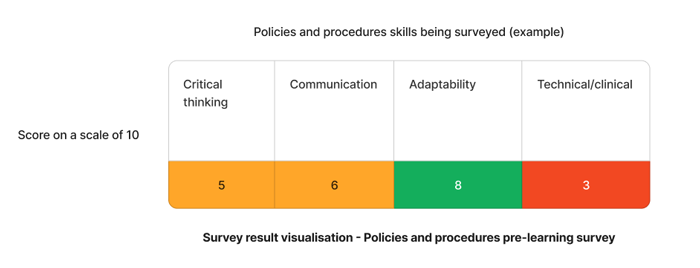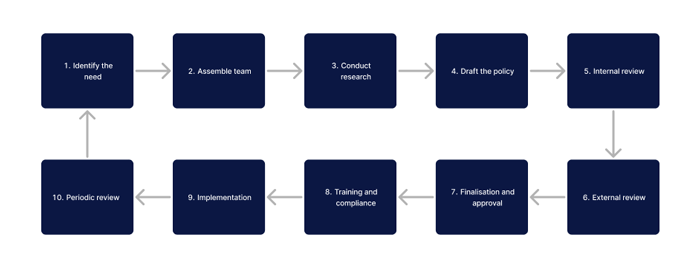This article is part of our Training Requirement Series where we provide comprehensive guides to meet the actual training requirements that are often needed/requested of learning and development departments within Australia's healthcare organisations. This series includes both general requirements, such as policies and procedures, but also focuses on the specific requirements stemming from the NDIS, Aged Care and NSQHS Quality Standards.
What are Policies and Procedures?
In essence, policies serve as the 'what' and 'why' of an organisation's goals, while procedures detail the 'how.' Policies are broad guidelines or rules established to direct the organisation's decision-making and activities. These are generally strategic, setting the stage for the organisation's mission and vision. Procedures, in contrast, are far more tactical. They offer a step-by-step guide on how to perform specific tasks. In healthcare, both are integral in maintaining quality and safety standards, such as infection control procedures or ethical treatment policies.
Want to learn more about policies and procedures? View our Guide to Policies and Procedures for Healthcare Managers here
What is the 'Policies and Procedures' Training Requirement?
For effective implementation, understanding policies and procedures is not optional—it's mandatory. Staff must familiarise themselves with evidence-based practice such as clinical care guidelines as well as the local policy and procedures at their organisation. It is vital that staff are practicing within their scope of practice when performing a task. Clinical practice guidelines and evidence-based research is the ingredient for policy development. This means periodic training should be more than a mere formality; it should be a rigorous, ongoing process that ensures compliance and promotes best practices.
Relevant Standards
Action 1.07: Policies and Procedures
- Regularly assess policies, procedures, and protocols to ensure they are in accordance with state or territorial regulations and accurately represent the most up-to-date practices and current evidence
National Safety and Quality Health Service (NSQHS) Standards
Action 2.7.4: Policies and Procedures must be:
- Current
- Regularly reviewed
- Informed by contemporary evidence-based practices
- Understood, communicated and accessibly to workers
Strengthened Quality Standards framework analysis - Aged Care Quality Standards
Failure to comply with the requirements could lead to an organisation being penalised or reprimanded.
How Can Organisations Maintain Compliance to this Standard?
There are multiple ways in which policies and procedures can be maintained and managed in accordance to the NSQHS and Strengthened Aged Care Standards. The most optimal of those is utilising an all-in-one workforce capability system for healthcare that integrates policy management, learning management and more.
Ausmed's organisational offering also supports the integration of learning management and policy management, all in one product!
Skills Needed for Healthcare Staff to Develop Policies and Procedures Knowledge
As healthcare professionals aim to offer top-notch patient care, a robust understanding of nutrition and hydration is non-negotiable. While earlier we discussed a variety of skills including menu development, this piece will explore additional competencies required for excelling in nutrition and hydration management. These are crucial across various healthcare settings, including aged care, public and private hospitals, and disability care facilities.
| Skill | Key Elements |
|---|---|
| Critical Thinking |
Staff should be adept at analysing and interpreting policy documents. This skill is crucial for understanding the underlying rationale and the implications of these policies. |
| Communication |
Effective communication skills ensure that staff can articulate questions and clarifications about policies, disseminate information accurately, and document activities in line with procedural requirements. |
| Adaptability |
Healthcare is a rapidly evolving field. Staff need to be agile and willing to adapt to new policies as they evolve, often at a fast pace. |
| Technical/Clinical |
Healthcare workers need to be able to implement the guideleines in a clinical and care setting in order to facilitate positive patient outcomes and maintaining compliance to the standards. |
How to Assess Staff Competency in Polcies and Procedures
Assessing staff competency is the first step in understanding what skills need to be developed by staff, and the appropiate training required to fill these gaps. A well-rounded approach is often best, utilising various methods to evaluate both understanding and practical application.
Methods of Assessing Staff Competency in Policies and Procedures
Staff competency can be assessed in the following methods:
- Regular Audits
Periodic audits provide a snapshot of how well policies and procedures are being followed. The audits can be department-specific or organisation-wide, focusing on high-risk areas or more generalised processes. They should be conducted by internal or external experts and should aim to identify deviations and recommend corrective actions. - Role-playing Exercises
Role-playing exercises offer an interactive way to assess how well staff understand and can apply policies in real-life scenarios. For example, simulating a medical emergency can evaluate how well staff adhere to hospital protocols. Such exercises are also an excellent way for staff to receive immediate feedback and for assessors to identify areas of improvement. - Written Exams
While they may seem traditional, written exams remain a reliable method for evaluating theoretical knowledge. Exams can be multiple-choice or require more complex answers. They can test the employee's understanding of specific procedures, policy frameworks of the Aged Care Quality and Safety Commission or the Australian Commission on Safety and Quality in Health Care. - Peer Reviews
Peer reviews allow for staff to assess each other's understanding and implementation of policies and procedures. This method can be especially helpful for understanding how well the team collaborates under established guidelines, although it should be complemented with more objective forms of assessment. - Self-Assessments
These can be particularly useful as a preliminary measure of staff knowledge. Self-assessments can provide employees with the chance to reflect on their understanding, thereby identifying areas they might need to focus on during formal training sessions. - Competency Checklists
A comprehensive competency checklist can serve as an ongoing tool for assessment. Staff can be asked to demonstrate proficiency in various tasks, from simple activities like handwashing techniques to complex tasks like handling bio-waste as per protocols. Checklists can be used for both initial training and periodic re-evaluations.
Strategies to Support Healthcare Staff Improve Policy and Procedure Competency
Develop customised training programs that are aligned with your healthcare setting. This would include hands-on training, workshops, and e-learning modules. Using your Learning Management System (LMS) can make tracking and assessment easier.
Given the importance of polcies and procedures, specified training and strategies must be facilitated in order to develop staff competency, adhere to the requirement set out by the NSQHS and the Aged Care Quality and Safety Commiion.
- Regular Training: Frequent workshops or training sessions not only reinforce existing knowledge but also introduce new updates in a controlled, focused environment.
- Mentorship: Newer or less-experienced staff can greatly benefit from mentorship programs where they're paired with seasoned professionals.
- Feedback Loop: Encouraging a culture of feedback can identify gaps in understanding and areas for improvement. This mechanism should be both bottom-up and top-down, creating a two-way channel for communication.
Sample Training Plan for the Policies and Procedures Training Requirement
Ensuring staff are competent in policy and procedures skills and knowledge is vital for your organisation to remain compliant to the Standards. Below is an sample training plan that aligns with Australian standards such as the Aged Care Standards, and NSQHS - based on a mock competency assessment survey.

Using the above image as an example - The skill that requires the most attention is "technical/clinical" skills.
| Quarter | Topics | Resources |
|---|---|---|
| Q1 | Technical/Clinical |
Need a policy management solution for your organisation?
Contact Ausmed today and see how you can manage policies with ease!
Staff Competency Assessment for Policies and Procedures - Example
The following is an example survey that learning and development coordinators may use to asses staff competency on policies and procedures.
Staff Survey - Policies and Procedure Competency
-
How comfortable are you with reading and interpreting policy documents?
- 1. Not comfortable at all
- 2. Somewhat comfortable
- 3. Comfortable
- 4. Very comfortable
- 5. Extremely comfortable
-
How often do you consult the policies and procedures manual during your work?
- 1. Not often at all
- 2. Somewhat often
- 3. Often
- 4. Very often
- 5. Extremely often
-
How do you keep updated on new policies or changes to existing ones?
- [Answer here]
-
Have you ever faced a situation where there was no existing policy or procedure?
- 1. Yes
- 2. No
-
How would you handle a colleague who is not following established procedures?
- [Answer here]
-
Do you know how to report a policy violation?
- 1. Yes
- 2. Somewhat
- 3. No
Policy and Procedure Writing Process in Healthcare
Now that you know the policy and procedure training requirement for healthcare, you can begin to action this information for your organisation. Below is a modified polciy and procedure process based on the Australian Employee Manual (Australian Employee Manual, 2021)

Step 1: Identifying the Need
The first step in the policy writing process is to identify a clear need for the policy. This could stem from new legal requirements, identified gaps in existing policies, or emerging healthcare practices that necessitate policy development.
Step 2: Assembling a Team
Convene a multidisciplinary team that brings together clinical experts, administrators, and legal advisors. This team will be responsible for drafting, reviewing, and finalising the policy.
Step 3: Conducting Research
Conduct thorough research to inform the policy. This may include reviewing existing guidelines, scientific literature, and best practices. For instance, for a policy on infection control, consult resources from the Australian Commission on Safety and Quality in Health Care.
Step 4: Drafting the Policy
The team should now draft the policy document, ensuring it is clear, concise, and aligned with organisational objectives and legal frameworks. Make sure to include a statement of purpose, scope, definitions, and detailed procedures where applicable.
Step 5: Internal Review
Before publicising the policy, an internal review must be conducted. This should involve team members, as well as other stakeholders who were not initially involved but are knowledgeable about the policy's focus area.
Step 6: External Review
An external review, ideally by experts in the field or relevant bodies like the Aged Care Quality and Safety Commission, can provide an unbiased perspective and identify any areas that need refinement.
Step 7: Finalisation and Approval
Integrate the feedback from internal and external reviews and finalise the policy document. It should be then submitted to education, senior management or the board for formal approval.
Step 8: Implementation
Once approved, the policy should be disseminated across the organisation through multiple channels, ensuring it is easily accessible and understood by all staff.
Step 9: Training and Compliance
Staff should be familiar with where to access the policy and be notified of what policies have been updated as they are approved and uploaded.
Step 10: Periodic Review
Policies are not static; they should be reviewed within a 12 month period. Additionally - they should be reviewed earlier if there has been clinical guideline, compliance or legislative update to ensure they remain relevant and effective.
The governing authority should assign the task of creating and updating policies, procedures, and protocols. This involves designating a responsible individual who will oversee the documentation of the procedures involved in developing, reviewing, and ensuring adherence to these policies, procedures, and protocols
Conclusion
Building a robust training program for understanding and implementing policies and procedures is more than a compliance requirement; it's a strategic investment in healthcare quality and safety.
References
- Australian Commission on Safety and Quality in Health, 2023. 'Patient safety and quality systems'
- Australian Commission on Safety and Quality in Health, 2023. 'NSQHS Action 1.07 - Policies and Procedures'
- Aged Care Quality and Safety Commission, 2023. 'Stronger Standards, Better Aged Care Program - Action 2.7.4'
- Australian Employee Manual, 2021. 'How to Write Workplace Policies and Procedures'


